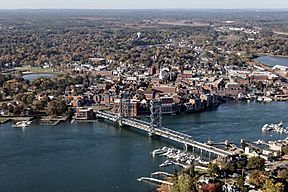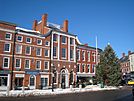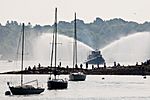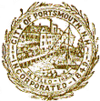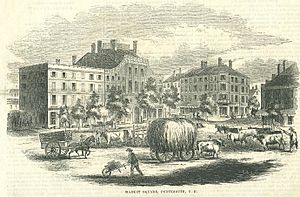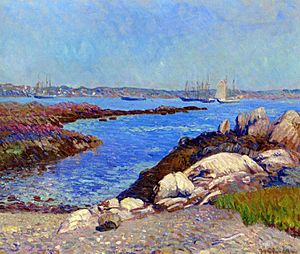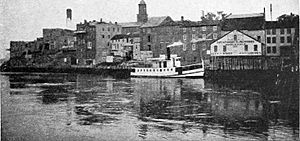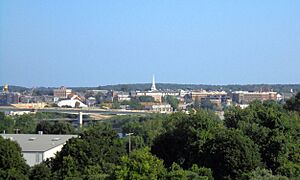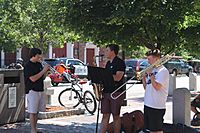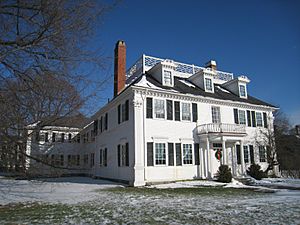Portsmouth, New Hampshire facts for kids
Quick facts for kids
Portsmouth, New Hampshire
|
||
|---|---|---|
|
City
|
||
|
Left to right from top: Aerial view of Portsmouth, Market Square, a naval fireboat in Portsmouth, Chestnut Street Arch and historic North Church.
|
||
|
||
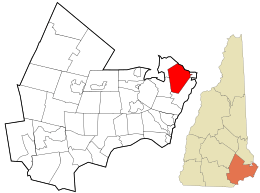
Location in Rockingham County and the state of New Hampshire.
|
||
| Country | United States | |
| State | New Hampshire | |
| County | Rockingham | |
| Settled | 1630 | |
| Incorporated | 1653 | |
| Incorporated (city) | 1849 | |
| Named for | Portsmouth, Hampshire | |
| Area | ||
| • Total | 16.82 sq mi (43.57 km2) | |
| • Land | 15.66 sq mi (40.56 km2) | |
| • Water | 1.16 sq mi (3.01 km2) 6.92% | |
| Elevation | 25 ft (8 m) | |
| Population
(2020)
|
||
| • Total | 21,956 | |
| • Density | 1,401.95/sq mi (541.31/km2) | |
| Time zone | UTC−5 (Eastern) | |
| • Summer (DST) | UTC−4 (Eastern) | |
| ZIP codes |
03801–03804
|
|
| Area code(s) | 603 | |
| FIPS code | 33-62900 | |
| GNIS feature ID | 0869312 | |
Portsmouth is a city in Rockingham County, New Hampshire, United States. In 2020, about 21,956 people lived there. It's a historic seaport and a popular place for tourists in the summer. Portsmouth is located on the Piscataqua River, which borders the state of Maine. It used to be home to Pease Air Force Base, which is now the Portsmouth International Airport at Pease.
Contents
A Look Back at Portsmouth's History
Early Days and Settlement
Long before Europeans arrived, Native American tribes like the Abenaki lived in the coastal area of New Hampshire.
The first European to explore this area was Martin Pring in 1603. The Piscataqua River has a strong current but forms a great natural harbor. European settlers arrived on the west bank of the harbor in 1630. They called their village Strawbery Banke because of the many wild strawberries growing there. A fort called Fort William and Mary protected the village.
Portsmouth became a busy port because it was good for trade. Fishing, lumber, and shipbuilding were important businesses. Sadly, slavery was part of the city's early history. Enslaved Africans were brought in as laborers as early as 1645. They played a role in building the city's wealth. Portsmouth was part of the "Triangle Trade," which involved making money from slavery.
In 1653, the town was officially named "Portsmouth." It was named after the English port of Portsmouth, Hampshire, where the colony's founder, John Mason, had been a captain.
Wars and Changes
After Queen Anne's War ended in 1712, Portsmouth was chosen for peace talks. These talks led to the 1713 Treaty of Portsmouth. This treaty helped stop fighting between the Abenaki people and the colonies of Massachusetts Bay and New Hampshire.
In 1774, before the American Revolution, Paul Revere rode to Portsmouth. He warned that the British Royal Navy was coming to take the port. Even though Fort William and Mary protected the harbor, the government moved the capital inland. This kept it safe from the Royal Navy. Portsmouth also received supplies like artillery and gunpowder to help the American fight for freedom.
African Americans helped defend Portsmouth during the war. In 1779, 19 enslaved African Americans from Portsmouth asked the state to end slavery. They pointed out their contributions to the war and the ideals of the Revolution. Their request was not immediately granted. New Hampshire ended slavery in 1857.
The Embargo Act of 1807 by Thomas Jefferson hurt trade with Britain. This caused some businesses in Portsmouth to fail. During the War of 1812, Portsmouth was home to many privateers, who were private ships authorized to attack enemy vessels. In 1849, Portsmouth officially became a city.
Building and Growth
Portsmouth was once one of the busiest ports and shipbuilding cities in the nation. Its wealth was shown in its beautiful buildings. You can still see many Colonial, Georgian, and Federal style houses, some of which are now museums.
After big fires in the early 1800s, especially one in 1813 that burned 244 buildings, new rules were made. Buildings in the downtown area had to be made of brick with slate roofs. This is why the downtown area looks so unique today.
The Industrial Revolution caused growth to shift to new factory towns in New Hampshire. Portsmouth's port became less important. However, the city survived and later focused on preserving its history.
Preserving History
In the 20th century, Portsmouth created a Historic District Commission. This group works to protect the city's amazing old buildings. In 2008, the National Trust for Historic Preservation called Portsmouth one of the "Dozen Distinctive Destinations." The downtown area is easy to walk around and attracts tourists and artists. They enjoy the cafes, restaurants, and shops around Market Square. Every year, Portsmouth celebrates its downtown with Market Square Day.
The city's focus on history came after some difficult times. Like many cities, Portsmouth went through "Urban Renewal." This was a plan to use federal money to fix up downtown areas. In Portsmouth, the North End neighborhood was chosen for this. It had many old houses and businesses.
In the mid-1960s, plans were made to tear down about 200 buildings, a school, and a church. This would force about 300 families to move. In 1968, a group called Portsmouth Preservation Inc. formed to save historic buildings. After a big effort, only fourteen houses were saved and moved to an area now called "The Hill." This event helped lead to the creation of the city's historic district.
Shipbuilding and Famous Treaties
Portsmouth's shipbuilding history is closely linked with Kittery, Maine, which is across the Piscataqua River. In the late 1700s, naval hero John Paul Jones lived in Portsmouth. He oversaw the building of his ship, the Ranger, which was built in Kittery. He stayed at the John Paul Jones House, which is now a museum. This house was built by Hopestill Cheswell, an African American master builder, and is a National Historic Landmark.
The Portsmouth Naval Shipyard was started in 1800. It is on Seavey's Island in Kittery, Maine. This base is famous for where the Treaty of Portsmouth was signed in 1905. This treaty ended the Russo-Japanese War. US President Theodore Roosevelt helped arrange the peace conference. He won the 1906 Nobel Peace Prize for his efforts.
Where is Portsmouth?
Geography of the City
Portsmouth covers about 43.6 square kilometers (16.8 square miles). Most of this is land, with about 3.0 square kilometers (1.16 square miles) being water. The city has streams like Berrys Brook and Sagamore Creek. The Piscataqua River forms the border between New Hampshire and Maine. The highest point in Portsmouth is about 25 feet (7.6 meters) above sea level, located at Pease International Airport.
Portsmouth's Climate
Portsmouth has a climate with warm summers and cold, snowy winters. The hottest temperature ever recorded in Portsmouth was 104°F (40°C) on August 2, 1975. The coldest temperature was -26°F (-32°C) on January 22, 1984.
| Climate data for Portsmouth, New Hampshire, 1991–2020 normals, extremes 1954–present | |||||||||||||
|---|---|---|---|---|---|---|---|---|---|---|---|---|---|
| Month | Jan | Feb | Mar | Apr | May | Jun | Jul | Aug | Sep | Oct | Nov | Dec | Year |
| Record high °F (°C) | 71 (22) |
75 (24) |
89 (32) |
94 (34) |
94 (34) |
97 (36) |
102 (39) |
104 (40) |
96 (36) |
88 (31) |
78 (26) |
75 (24) |
104 (40) |
| Mean maximum °F (°C) | 55.3 (12.9) |
56.8 (13.8) |
66.0 (18.9) |
81.2 (27.3) |
88.1 (31.2) |
91.3 (32.9) |
93.6 (34.2) |
92.0 (33.3) |
88.3 (31.3) |
78.4 (25.8) |
68.9 (20.5) |
57.8 (14.3) |
95.3 (35.2) |
| Mean daily maximum °F (°C) | 32.6 (0.3) |
35.6 (2.0) |
43.3 (6.3) |
55.8 (13.2) |
66.1 (18.9) |
75.0 (23.9) |
80.5 (26.9) |
79.4 (26.3) |
71.8 (22.1) |
59.7 (15.4) |
48.1 (8.9) |
37.8 (3.2) |
57.1 (14.0) |
| Daily mean °F (°C) | 24.4 (−4.2) |
26.6 (−3.0) |
34.3 (1.3) |
45.3 (7.4) |
55.4 (13.0) |
64.5 (18.1) |
70.3 (21.3) |
69.1 (20.6) |
61.7 (16.5) |
50.1 (10.1) |
39.7 (4.3) |
30.0 (−1.1) |
47.6 (8.7) |
| Mean daily minimum °F (°C) | 16.3 (−8.7) |
17.6 (−8.0) |
25.3 (−3.7) |
34.8 (1.6) |
44.8 (7.1) |
54.1 (12.3) |
60.1 (15.6) |
58.8 (14.9) |
51.7 (10.9) |
40.5 (4.7) |
31.2 (−0.4) |
22.3 (−5.4) |
38.1 (3.4) |
| Mean minimum °F (°C) | −4.2 (−20.1) |
−1.2 (−18.4) |
6.4 (−14.2) |
22.7 (−5.2) |
31.1 (−0.5) |
41.2 (5.1) |
49.4 (9.7) |
47.5 (8.6) |
35.4 (1.9) |
26.4 (−3.1) |
16.1 (−8.8) |
4.8 (−15.1) |
−6.9 (−21.6) |
| Record low °F (°C) | −26 (−32) |
−15 (−26) |
−8 (−22) |
10 (−12) |
15 (−9) |
32 (0) |
38 (3) |
33 (1) |
23 (−5) |
14 (−10) |
−6 (−21) |
−17 (−27) |
−26 (−32) |
| Average precipitation inches (mm) | 3.63 (92) |
3.57 (91) |
4.77 (121) |
4.56 (116) |
3.95 (100) |
4.59 (117) |
3.89 (99) |
3.66 (93) |
4.08 (104) |
4.95 (126) |
4.12 (105) |
4.88 (124) |
50.65 (1,288) |
| Average snowfall inches (cm) | 17.1 (43) |
15.8 (40) |
13.9 (35) |
2.3 (5.8) |
0.0 (0.0) |
0.0 (0.0) |
0.0 (0.0) |
0.0 (0.0) |
0.0 (0.0) |
0.1 (0.25) |
1.6 (4.1) |
14.2 (36) |
65.0 (165) |
| Average extreme snow depth inches (cm) | 11.0 (28) |
12.5 (32) |
11.2 (28) |
2.1 (5.3) |
0.0 (0.0) |
0.0 (0.0) |
0.0 (0.0) |
0.0 (0.0) |
0.0 (0.0) |
0.0 (0.0) |
0.8 (2.0) |
8.4 (21) |
17.9 (45) |
| Average precipitation days (≥ 0.01 in) | 10.6 | 9.3 | 10.9 | 11.1 | 11.3 | 11.3 | 10.7 | 8.7 | 9.1 | 10.6 | 10.9 | 11.3 | 125.8 |
| Average snowy days (≥ 0.1 in) | 6.9 | 5.9 | 4.6 | 0.9 | 0.0 | 0.0 | 0.0 | 0.0 | 0.0 | 0.0 | 1.0 | 5.3 | 24.6 |
| Source: NOAA | |||||||||||||
People and Economy
Who Lives in Portsmouth?
| Historical population | |||
|---|---|---|---|
| Census | Pop. | %± | |
| 1790 | 4,720 | — | |
| 1800 | 5,339 | 13.1% | |
| 1810 | 6,934 | 29.9% | |
| 1820 | 7,327 | 5.7% | |
| 1830 | 8,026 | 9.5% | |
| 1840 | 7,887 | −1.7% | |
| 1850 | 9,738 | 23.5% | |
| 1860 | 9,335 | −4.1% | |
| 1870 | 9,211 | −1.3% | |
| 1880 | 9,690 | 5.2% | |
| 1890 | 9,827 | 1.4% | |
| 1900 | 10,637 | 8.2% | |
| 1910 | 11,269 | 5.9% | |
| 1920 | 13,569 | 20.4% | |
| 1930 | 14,495 | 6.8% | |
| 1940 | 14,821 | 2.2% | |
| 1950 | 18,830 | 27.0% | |
| 1960 | 26,900 | 42.9% | |
| 1970 | 25,717 | −4.4% | |
| 1980 | 26,254 | 2.1% | |
| 1990 | 25,925 | −1.3% | |
| 2000 | 20,784 | −19.8% | |
| 2010 | 21,233 | 2.2% | |
| 2020 | 21,956 | 3.4% | |
| sources: | |||
Portsmouth is the only city in Rockingham County. However, it has fewer people than some towns in the county, like Derry, Londonderry, and Salem.
In 2010, there were 21,233 people living in Portsmouth. About 91.5% of the people were White, 1.7% African American, and 3.5% Asian. About 2.8% of the population was Hispanic or Latino. The average age in the city was 40.3 years old.
What is the Economy Like?
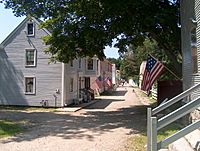
Several companies have their main offices in Portsmouth. These include Bottomline Technologies, which makes software, and Sweet Scoops, a frozen yogurt maker.
Top Employers in Portsmouth
Many people in Portsmouth work for these top employers:
| # | Employer | Employees |
|---|---|---|
| 1 | US Dept of State Consular Center | 1,300 |
| 2 | Lonza Biologics | 1,100 |
| 3 | Liberty Mutual | 1,000 |
| 4 | HCA Hospital | 1,000 |
| 5 | City of Portsmouth | 817 |
| 6 | Bottomline Technologies | 638 |
| 7 | John Hancock | 400 |
| 8 | Service Credit Union | 378 |
| 9 | Amadeus | 362 |
| 10 | High Liner Foods | 330 |
Arts, Culture, and Fun Things to Do
Downtown and Restaurants
The Portsmouth Downtown Historic District is the old heart of the city. Portsmouth is known for its many restaurants. In 2023, it was reported that the city had 36,000 restaurant seats, which is a lot for a city with 22,000 people!
Places to Visit and Explore
- USS Albacore Museum & Park – You can tour the USS Albacore, a U.S. Navy submarine used for testing.
- The Music Hall – A theater that opened in 1878 and seats 900 people.
- New Hampshire Theatre Project – A non-profit theater group that puts on plays and offers classes.
- North Church – A historic church whose tall steeple can be seen from most of Portsmouth.
- The Player's Ring Theater – A small theater that shows new plays by local writers.
- Pontine Theatre – This theater creates original shows about New England's history and culture.
- Portsmouth African Burying Ground – A special park and memorial. It's the only place in New England where an 18th-century African burying ground has been found.
- Portsmouth Athenæum – A private library, museum, and art gallery that is sometimes open to the public.
- Portsmouth Harbor Lighthouse – This lighthouse was first built in 1771. The current one is from 1878. You can take tours from May to September.
- Portsmouth Historical Society – This group runs a museum, gift shop, and offers walking tours. They also manage the John Paul Jones House.
- Prescott Park Arts Festival – A summer festival with entertainment in Portsmouth's waterfront park since 1974.
- Strawbery Banke Museum – A neighborhood with many old, restored homes from different time periods. It's where one of Portsmouth's first settlements was located.
Historic House Museums
You can visit many old houses that are now museums:
- Richard Jackson House (built in 1664)
- John Paul Jones House (built in 1758)
- Governor John Langdon House (built in 1784)
- Tobias Lear House (built in 1740)
- Moffatt-Ladd House (also called William Whipple House) (built in 1763)
- Rundlet-May House (built in 1807)
- MacPheadris-Warner House (built in 1716)
- Wentworth-Coolidge Mansion (built in 1750)
- Wentworth-Gardner House (also called Wentworth House) (built in 1760)
- Henry Sherburne House (built in 1766)
Sports and Education
Sports Teams
- Seacoast United Phantoms – A soccer team based in Portsmouth. They play in USL League Two.
- Freedom Rugby Football Club – A men's rugby union team started in 2014.
Schools and Colleges
The Portsmouth School District runs the public schools.
There are also several colleges and universities with campuses in Portsmouth:
- Community College System of New Hampshire, Great Bay Community College
- Franklin Pierce University
- Granite State College
For private schools, there is:
- Saint Patrick Academy – a Catholic school for grades K-8.
Media and Transportation
Local Media
- The New Hampshire Gazette
- The Portsmouth Herald
Radio
- WSCA-LP Portsmouth Community Radio 106.1 FM
- WHEB 100.3 FM (rock music)
Getting Around Portsmouth
Major roads like Interstate 95 and U.S. Route 1 pass through Portsmouth.
- Boston is about 55 miles (89 km) south.
- Portland, Maine, is about 53 miles (85 km) northeast.
- Dover, New Hampshire, is about 13 miles (21 km) northwest.
Public buses are run by the Cooperative Alliance for Seacoast Transportation (COAST). C&J is a private bus company that connects Portsmouth to Boston and New York City. Wildcat Transit offers bus service to the University of New Hampshire campus. You can also fly from Portsmouth International Airport at Pease (PSM) with Allegiant Air.
Sister Cities
Portsmouth has "sister cities" around the world, which means they have special friendly relationships:
 Agadir, Morocco
Agadir, Morocco Carrickfergus, Northern Ireland, United Kingdom
Carrickfergus, Northern Ireland, United Kingdom Kitase, Ghana
Kitase, Ghana Nichinan, Japan
Nichinan, Japan Pärnu, Estonia
Pärnu, Estonia Severodvinsk, Russia
Severodvinsk, Russia
Portsmouth also has friendly relations with:
 Portsmouth, England, United Kingdom
Portsmouth, England, United Kingdom Santarcangelo di Romagna, Italy
Santarcangelo di Romagna, Italy Szolnok, Hungary
Szolnok, Hungary
Notable People from Portsmouth
See also
 In Spanish: Portsmouth (Nuevo Hampshire) para niños
In Spanish: Portsmouth (Nuevo Hampshire) para niños


